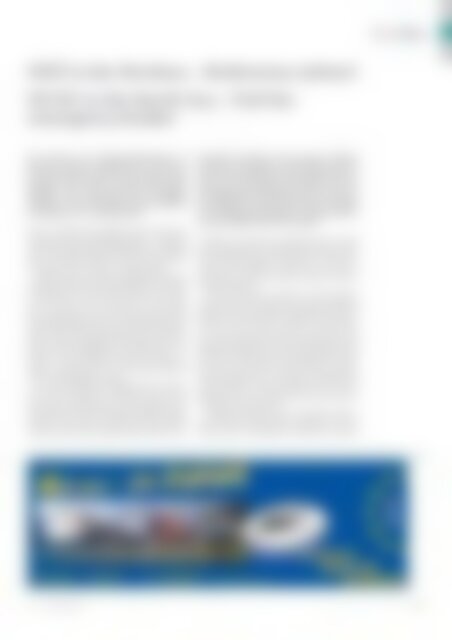eb - Elektrische Bahnen Bahnenergieversorgungssystem der DB erneut bestätigt (Vorschau)
Sie wollen auch ein ePaper? Erhöhen Sie die Reichweite Ihrer Titel.
YUMPU macht aus Druck-PDFs automatisch weboptimierte ePaper, die Google liebt.
Thema Fokus<br />
HGÜ in <strong>der</strong> Nordsee – Notbremse ziehen!<br />
HV DC in the North Sea – Pull the<br />
emergency brake!<br />
Die Nutzung <strong>der</strong> Offshore-Windenergie ist<br />
blockiert, weil die Anbindungen an das deutsche<br />
Festlandsnetz fehlen. Als Grund wird die<br />
gewählte, aber dafür neuartige HGÜ angeprangert.<br />
Eine einsatzreife und viel billigere<br />
Alterative ist die seit hun<strong>der</strong>t Jahren bewährte<br />
zuverlässige 16 2 /3-Hz-Bahntechnik.<br />
Dass es mit 50 Hz nicht klappen würde, hatte man<br />
in Berlin offenbar frühzeitig verstanden – schließlich<br />
sind Politiker verpflichtet, Blindleistung zu erkennen<br />
und zu vermeiden. Warum hat man sich aber dann<br />
das Teuerste vom Teuersten verkaufen lassen?<br />
HGÜ ist dazu gut, mehrere tausend Kilometer per<br />
Freileitung o<strong>der</strong> viele hun<strong>der</strong>t Kilometer per Kabel<br />
zu überbrücken. Bei den Entfernungen in <strong>der</strong> Nordsee<br />
ist sie purer Luxus, <strong>der</strong> nicht nur Zeit son<strong>der</strong>n<br />
auch Geld kostet. Ihre Ausrüstung und die dafür<br />
notwendigen Basisstationen, mit Riesenplattformen<br />
jede aus mehr Eisen als <strong>der</strong> Eiffelturm hat und Kathedralen<br />
voller Leistungselektronik darauf, bieten das<br />
heute maximal Mögliche an Projektierungs-, Produktions-<br />
und Montageleistungen. Das nutzen zu<br />
wollen ist legitim, aber nur zur Arbeitsbeschaffung<br />
solte es nicht geför<strong>der</strong>t werden.<br />
Als unsere Vorfahren vor hun<strong>der</strong>t Jahren merkten,<br />
dass sie bei elektrischen Fernbahnen mit DC nicht<br />
weit kommen würden o<strong>der</strong> es nicht bezahlen könnten<br />
und dass AC 50 Hz die Motoren kaputt machte,<br />
nahmen und normten sie dafür 16 2 /3 Hz. Mit dieser<br />
Synthese aus den guten Eigenschaften bei<strong>der</strong> Strom-<br />
Utilization of offshore wind energy is blocked<br />
because of missing links to the German onshore<br />
grid. HV DC transmission technology which was<br />
chosen for this purpose but which is new for<br />
this application was blamed to be the reason for<br />
that. Approved since hundred years the reliable<br />
16 2 /3 Hz railway technology is an option which is<br />
directly available and much cheaper.<br />
In Berlin, they obviously un<strong>der</strong>stood early enough<br />
that utilizing 50 Hz for transmitting power from offshore<br />
windpower plants will not work – by all means<br />
politicians are obliged to identify and to avoid reactive<br />
power. But why did they accept the utmost<br />
expensive solution?<br />
HV DC transmission is suitable to cover thousands<br />
of kilometres by overhead line or several hundreds of<br />
kilometres by buried cable. Regarding the off-shore<br />
distances in the North Sea, however, this technology<br />
is just luxury and will waste not only time but<br />
also money. Because the HV DC equipments and the<br />
platforms to bear them, each one consisting of more<br />
steel than the Eiffel tower and topped with cathedrals<br />
full of power electronics offer today’s maximum<br />
business-opportunity in projecting, manufacturing<br />
and construction. Trying to make use of all this is<br />
legitimate, but only for employment policy purposes<br />
it should not be supported.<br />
Hundred years ago, when our ancestors had to<br />
learn that DC would be either insufficient or invaluable<br />
for electric long distance railway lines and that<br />
Mit uns - für EUROPA<br />
Anzeige<br />
Zertifizierungen von Bahnsystemen und Komponenten in Europa<br />
Benannte Stelle<br />
Interoperabilität<br />
Heinemannstr. 6<br />
D-53175 Bonn<br />
Tel.: +49 (228) 9826-700<br />
Fax: +49 (228) 9826-711<br />
www.eisenbahn-cert.de<br />
Partner <strong>der</strong><br />
<strong>Bahnen</strong> und<br />
<strong>der</strong> Industrie<br />
EBC_4c_176x59.indd 1<br />
111 (2013) Heft 3<br />
21.04.2009 13:05:13 Uhr<br />
157

















